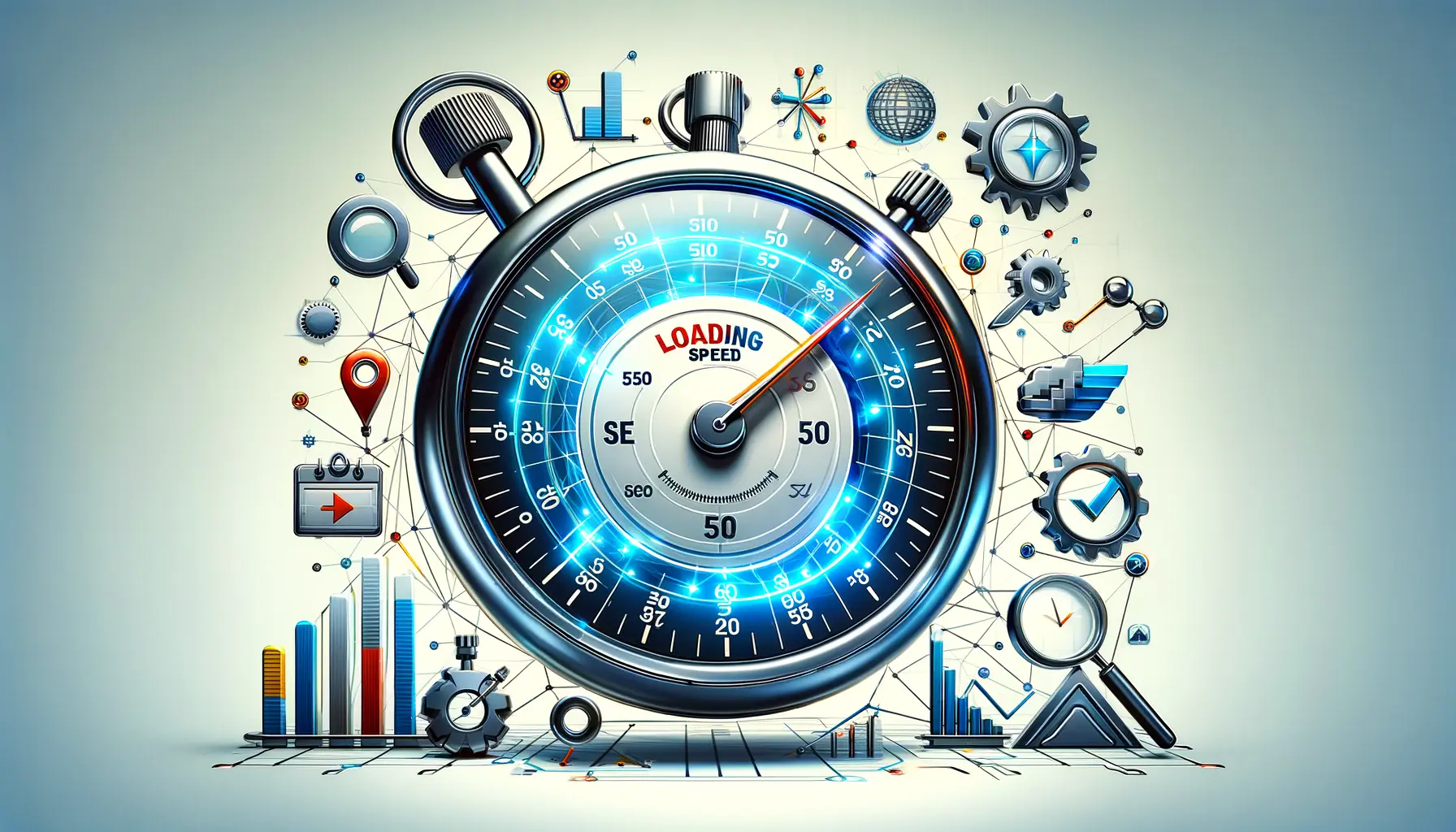Speed optimization has become a cornerstone of Technical SEO, serving as a critical factor in enhancing website performance and user experience.
In today’s digital age, where the patience of online users dwindles and the demand for instant information rises, the speed at which a website loads can significantly impact its success.
This aspect of Technical SEO not only influences how users engage with a site but also affects its visibility and ranking on search engines.
By prioritizing speed, websites can improve their search engine rankings, retain visitors, and ultimately, convert more leads.
Understanding the intricacies of speed optimization requires a deep dive into the technical elements that contribute to a website’s loading time.
These include server response times, file sizes, and the efficiency of code, among others.
Optimizing these factors ensures that a website not only meets but exceeds the expectations of modern web users, providing them with a seamless and enjoyable browsing experience.
As we explore the realm of Technical SEO, it becomes evident that speed is not just a luxury but a necessity for any website aiming to thrive in the competitive online landscape.
- Understanding the Basics of Speed Optimization
- Strategies for Effective Speed Optimization
- Enhancing User Experience Through Speed Optimization
- Technical SEO Audits for Speed Optimization
- Mobile Optimization and Speed
- Advanced Speed Optimization Techniques
- Monitoring and Maintaining Website Speed
- Conclusion: The Imperative of Speed in Technical SEO
- FAQs on Speed Optimization for Technical SEO
Understanding the Basics of Speed Optimization
At the heart of speed optimization lies the principle of reducing the time it takes for pages to load, thereby enhancing the overall user experience.
This process begins with an assessment of current performance metrics, utilizing tools that analyze page speed and identify bottlenecks.
It’s crucial for webmasters to understand the various elements that can slow down a website, such as unoptimized images, excessive HTTP requests, and bulky code.
Implementing best practices for speed optimization involves a multifaceted approach.
Techniques such as image compression, browser caching, and minimizing CSS and JavaScript files can lead to significant improvements in loading times.
Additionally, adopting advanced strategies like using a Content Delivery Network (CDN) and optimizing server response time are essential for websites with a global audience.
These efforts not only enhance the user experience but also contribute positively to a website’s SEO performance, as search engines favor fast-loading sites.
Key Factors Influencing Website Speed
Several critical factors play a role in determining a website’s speed.
First and foremost, the web hosting service’s quality can significantly impact loading times.
Choosing a reliable hosting provider that offers fast server responses is fundamental.
Secondly, the size and optimization of media files, including images and videos, can drastically affect page speed.
Employing techniques like lazy loading and image compression can mitigate these issues.
Moreover, the efficiency of the website’s code is another vital component.
Clean, well-structured, and minimized code ensures faster parsing and rendering by browsers.
Lastly, the number of plugins and third-party scripts can also slow down a website.
It’s essential to regularly audit these elements and remove or replace those that negatively impact speed.
By addressing these key factors, websites can achieve better performance and a competitive edge in search rankings.
Optimizing website speed is not just about improving user experience but also about enhancing a site’s SEO performance and visibility on search engines.
Strategies for Effective Speed Optimization
Developing a comprehensive strategy for speed optimization involves a combination of technical adjustments, content management, and ongoing monitoring.
By systematically addressing the factors that contribute to slow loading times, businesses can significantly enhance their website’s performance.
Here are some effective strategies that form the core of speed optimization in Technical SEO:
Optimizing Images and Media
High-quality images and media are essential for engaging content, but they can also be the biggest culprits in slowing down your website.
Implementing the following practices can help reduce their impact on speed:
- Compression: Use tools to compress images without sacrificing quality, ensuring they load faster without degrading the user experience.
- Appropriate Formats: Choose the right file formats (e.g., JPEG for photos, PNG for graphics) for optimal balance between quality and file size.
- Responsive Images: Implement responsive image techniques to serve different image sizes based on the user’s device, reducing unnecessary data usage.
Minimizing Code and Utilizing Caching
Optimizing the codebase and leveraging browser caching can dramatically improve site speed.
Key actions include:
- Minifying CSS, JavaScript, and HTML: Remove unnecessary characters from code to reduce its size and improve load times.
- Using Browser Caching: Configure your server to enable browser caching, allowing repeat visitors to load your site faster by storing elements of your site locally.
Leveraging Advanced Technologies
Adopting cutting-edge technologies and practices can further enhance your website’s speed and performance:
- Content Delivery Network (CDN): A CDN stores copies of your site on servers around the world, reducing the distance data must travel to reach your users.
- Accelerated Mobile Pages (AMP): Implementing AMP for mobile pages can drastically improve loading times on mobile devices.
By integrating these strategies into your Technical SEO efforts, you can ensure that your website not only meets but exceeds the speed expectations of today’s web users.
This not only improves user satisfaction but also strengthens your site’s SEO, as speed is a key ranking factor for search engines.
Regularly monitoring and updating your website’s speed optimization strategies is crucial for maintaining optimal performance and search engine rankings.
Enhancing User Experience Through Speed Optimization
Speed optimization plays a pivotal role in enhancing the overall user experience (UX) on a website.
A site that loads quickly and seamlessly provides a positive experience for visitors, encouraging them to stay longer and engage more deeply with the content.
This section explores how speed optimization directly impacts UX and outlines strategies to ensure your website offers an optimal experience for all users.
Impact of Speed on User Behavior
The speed at which a website loads can significantly influence user behavior and engagement.
Studies have shown that websites taking longer than a few seconds to load experience higher bounce rates, as users are likely to abandon a site that doesn’t load promptly.
Faster websites, on the other hand, see increased time on site, higher levels of engagement, and improved conversion rates.
This direct correlation between site speed and user satisfaction underscores the importance of optimizing for speed to enhance UX.
Moreover, speed optimization affects how users perceive a brand.
A fast-loading site is often associated with professionalism, reliability, and a high level of customer service.
Conversely, a slow website can frustrate users, potentially harming the brand’s reputation and driving potential customers to competitors.
Strategies to Improve UX Through Speed
Improving the user experience through speed optimization involves several key strategies:
- Optimize Above-the-Fold Content: Prioritize the loading of content that appears above the fold to ensure users have something to engage with immediately.
- Lazy Loading: Implement lazy loading for images and videos, loading these elements only as they come into the browser’s viewport. This reduces initial load times and saves bandwidth for users.
- Mobile Optimization: Given the increasing prevalence of mobile browsing, ensuring your site is optimized for mobile devices is crucial. This includes responsive design and mobile-specific speed optimizations.
- User Feedback: Incorporate user feedback mechanisms to identify areas of your site that may be experiencing performance issues. This direct input can guide your optimization efforts more effectively.
By focusing on these strategies, websites can significantly improve the UX, leading to higher satisfaction rates, increased engagement, and better conversion rates.
Speed optimization is not just a technical necessity but a critical component of a successful user-centric web strategy.
Consider user experience as a continuous improvement process, where speed optimization is an ongoing effort rather than a one-time task.
Technical SEO Audits for Speed Optimization
Conducting regular technical SEO audits is essential for identifying and addressing issues that may be affecting your website’s speed.
These audits allow you to pinpoint specific areas where improvements can be made, ensuring that your site remains optimized for both search engines and users.
This part of the article delves into the key components of a technical SEO audit focused on speed optimization and how to effectively implement changes based on audit findings.
Key Components of a Speed Optimization Audit
A comprehensive speed optimization audit examines various aspects of your website to identify potential bottlenecks.
Essential components of this audit include:
- Page Load Times: Utilizing tools to measure the time it takes for pages to fully load, identifying pages that fall below the optimal speed threshold.
- Server Response Times: Assessing the efficiency of your server in handling requests, which can significantly impact overall site speed.
- Resource Optimization: Analyzing the size and format of images, scripts, and stylesheets to identify opportunities for compression and minification.
- Render-Blocking Resources: Identifying CSS and JavaScript that may be blocking the page from rendering until they are fully loaded and exploring strategies to defer or asynchronously load these resources.
Implementing Audit Findings
Once the audit is complete, the next step is to implement the findings to improve your website’s speed.
This process involves:
- Prioritizing Fixes: Not all issues will have the same impact on your site’s speed, so it’s important to prioritize changes that will offer the most significant improvements.
- Optimizing Resources: Based on the audit, take steps to compress images, minify CSS and JavaScript, and leverage browser caching to reduce load times.
- Improving Server Response: If server response times are slow, consider upgrading your hosting plan, optimizing server configurations, or using a Content Delivery Network (CDN) to improve speed.
- Monitoring Changes: After implementing changes, continuously monitor your site’s speed to ensure that the optimizations are having the desired effect and to identify any new issues that may arise.
Regular technical SEO audits for speed optimization are crucial for maintaining an efficient, user-friendly website.
By systematically addressing the issues identified in these audits, you can ensure that your site remains fast, competitive, and appealing to both users and search engines.
Regularly scheduled technical SEO audits are a best practice for identifying and rectifying speed-related issues before they impact user experience or search engine rankings.
Mobile Optimization and Speed
In the realm of Technical SEO, mobile optimization is a critical aspect that goes hand in hand with speed optimization.
With the majority of internet users accessing the web via mobile devices, ensuring your website is optimized for mobile is no longer optional; it’s imperative.
This part of the article explores the importance of mobile optimization in the context of speed and provides actionable strategies to enhance mobile user experience through faster loading times.
Importance of Mobile Speed
Mobile users expect quick, responsive interactions when browsing on their devices.
Google’s mobile-first indexing, which prioritizes the mobile version of content for indexing and ranking, underscores the importance of mobile speed.
A slow-loading mobile site can lead to increased bounce rates, lower engagement, and diminished search engine rankings.
Therefore, optimizing your website’s speed for mobile devices is crucial for both user satisfaction and SEO performance.
Moreover, mobile speed optimization can significantly impact conversion rates.
Faster mobile sites create a smoother browsing experience, encouraging users to stay longer and engage more deeply with your content, products, or services.
This enhanced user experience directly translates into higher conversion rates and increased revenue.
Strategies for Mobile Speed Optimization
To ensure your website offers a fast, efficient mobile experience, consider the following strategies:
- Responsive Design: Implement a responsive web design that automatically adjusts content layout based on the device’s screen size, improving loading times and usability.
- Accelerated Mobile Pages (AMP): Use AMP to create lightweight versions of your web pages for faster loading on mobile devices.
- Optimize Images: Ensure images are properly sized and compressed for mobile, reducing load times without compromising quality.
- Minimize Code: Like desktop optimization, minimizing the amount of CSS, JavaScript, and HTML on your mobile site can significantly improve speed.
- Test Mobile Speed: Regularly use mobile speed testing tools to identify areas for improvement and monitor the impact of your optimization efforts.
By prioritizing mobile optimization and speed, you can enhance the mobile user experience, improve SEO rankings, and drive better business outcomes.
As mobile internet usage continues to grow, the importance of mobile speed in Technical SEO cannot be overstated.
Mobile optimization is not just about resizing content for smaller screens; it’s about creating fast, accessible, and engaging experiences for mobile users.
Advanced Speed Optimization Techniques
For those looking to take their website’s speed optimization to the next level, advanced techniques offer the potential to further reduce load times and enhance user experience.
These methods go beyond basic optimizations, delving into the more technical aspects of web development and server configuration.
This part of the article highlights some of the most effective advanced speed optimization techniques that can make a significant difference in your website’s performance.
Implementing HTTP/2 and HTTP/3
HTTP/2 and HTTP/3 represent significant improvements over the older HTTP/1.1 protocol, offering enhanced speed and efficiency for web communications.
These protocols introduce multiplexing, allowing multiple requests and responses between the client and server to be intertwined on a single connection.
This reduces latency and improves load times.
Upgrading to a web server that supports these protocols can provide an immediate boost to your site’s performance.
Additionally, HTTP/3 further improves upon HTTP/2 by reducing connection setup times and improving performance over lossy network conditions.
Implementing these protocols requires server-side changes but can dramatically improve the speed of your website without altering its content.
Optimizing for Core Web Vitals
Google’s Core Web Vitals are a set of specific factors that Google considers important in a webpage’s overall user experience.
These include Largest Contentful Paint (LCP), First Input Delay (FID), and Cumulative Layout Shift (CLS).
Optimizing for these factors not only improves your website’s speed but also its SEO performance, as Google uses these metrics as part of its ranking criteria.
Strategies for optimizing Core Web Vitals include:
- LCP: Improve loading times for the largest content element visible in the viewport. This can involve optimizing images, prioritizing above-the-fold content, and reducing server response times.
- FID: Reduce the time from when a user first interacts with your site to the time when the browser is able to respond to that interaction. This often involves optimizing JavaScript execution.
- CLS: Minimize unexpected layout shifts during the loading of the page. This can be achieved by specifying size attributes for images and videos and ensuring ad elements have a reserved space.
By focusing on these advanced techniques, you can significantly enhance your website’s speed and user experience, further solidifying your site’s position in the competitive online landscape.
Advanced speed optimization not only caters to the immediate needs of users but also prepares your website for future technological advancements and search engine updates.
Assuming that basic speed optimizations are enough to compete in today’s fast-paced digital environment is a misconception. Advanced techniques are essential for achieving top performance and user satisfaction.
Monitoring and Maintaining Website Speed
Maintaining optimal website speed is an ongoing process that requires regular monitoring and updates.
As web technologies evolve and content updates are made, websites can gradually slow down if not properly maintained.
This final part of the article focuses on the importance of continuous monitoring and the best practices for maintaining website speed over time.
Continuous Speed Monitoring
Continuous monitoring is crucial for identifying speed issues as they arise.
Utilizing tools that provide real-time analytics and speed testing can help webmasters stay ahead of potential slowdowns.
These tools can alert you to performance dips, enabling quick action to rectify any issues.
Regularly scheduled speed tests should be part of your website’s maintenance routine, ensuring that loading times remain consistent and meet user expectations.
Moreover, monitoring should extend beyond desktop experiences to include mobile performance, considering the growing prevalence of mobile internet usage.
This comprehensive approach ensures that all users enjoy fast loading times, regardless of their device.
Best Practices for Speed Maintenance
To effectively maintain your website’s speed, consider the following best practices:
- Regularly Update Content and Code: Keep your website’s content and codebase up to date, removing outdated elements that could slow down your site.
- Optimize New Content: Ensure that all new content, especially images and videos, is optimized for speed before being added to your site.
- Stay Informed on Web Technologies: Keep abreast of the latest web technologies and speed optimization techniques. Implementing these advancements can provide a competitive edge.
- Revisit Hosting Solutions: Periodically review your hosting plan and provider to ensure they still meet your website’s speed and performance needs.
By adhering to these practices, you can maintain and even improve your website’s speed over time.
This proactive approach to speed maintenance not only enhances user experience but also supports your site’s SEO efforts, contributing to higher search engine rankings and increased visibility.
Consider website speed optimization as a journey rather than a destination. Continuous improvement and adaptation to new technologies are key to staying competitive in the digital space.
Conclusion: The Imperative of Speed in Technical SEO
In the digital age, where the competition for user attention is fierce, the speed of a website transcends mere convenience to become a critical element of Technical SEO.
This article has traversed the multifaceted landscape of speed optimization, highlighting its paramount importance not only for enhancing user experience but also for bolstering a website’s visibility and ranking on search engines.
As we’ve explored, the journey towards optimal website speed is ongoing, involving a blend of strategic planning, technical finesse, and continuous adaptation to evolving web standards and user expectations.
Key Takeaways for Speed Optimization
From understanding the basics of speed optimization to implementing advanced techniques and maintaining peak performance, several key takeaways emerge:
- Speed optimization is foundational to improving both user experience and SEO outcomes.
- Regular technical audits are essential for identifying and addressing speed-related issues.
- Mobile optimization is crucial, given the increasing dominance of mobile browsing.
- Advanced techniques, including HTTP/2 and HTTP/3 implementation and optimizing for Core Web Vitals, offer significant opportunities for speed enhancement.
- Continuous monitoring and maintenance are required to sustain optimal website speed over time.
As we’ve seen, speed optimization for Technical SEO is not a one-time task but a continuous effort that demands attention to detail, a proactive stance on web technology trends, and a commitment to delivering the best possible experience to users.
By embracing the strategies and practices outlined in this article, webmasters and SEO professionals can ensure their websites not only meet but exceed the speed expectations of today’s web users, thereby securing a competitive edge in the digital marketplace.
Looking Forward
Looking forward, the importance of speed in Technical SEO is only set to increase as internet technologies advance and user expectations evolve.
Websites that prioritize speed optimization today will be better positioned to adapt to future changes, whether they involve new web standards, search engine algorithms, or user behaviors.
In this context, speed optimization emerges not just as a technical necessity but as a strategic investment in the future success and resilience of a website.
In conclusion, the pursuit of speed within Technical SEO is a critical endeavor that can significantly impact a website’s performance, user satisfaction, and overall success.
By adopting a comprehensive and forward-thinking approach to speed optimization, websites can navigate the complexities of the digital landscape with agility and confidence, ensuring they remain relevant, competitive, and capable of delivering exceptional user experiences.
Want your website to top Google search rankings? Leave the SEO to our professional agency!
FAQs on Speed Optimization for Technical SEO
Explore commonly asked questions about enhancing your website’s speed within the realm of Technical SEO.
Technical SEO refers to optimizing a website’s technical aspects to improve its visibility and ranking on search engines, enhancing user experience.
Website speed affects user experience and search engine rankings, as faster sites are more likely to retain visitors and rank higher on search results.
Use online tools like Google PageSpeed Insights to analyze your website’s performance and receive actionable recommendations for improvement.
Core Web Vitals are a set of specific factors Google considers important in a webpage’s overall user experience, including loading performance, interactivity, and visual stability.
Optimizing images reduces their file size without compromising quality, significantly improving page load times and overall website speed.
A Content Delivery Network (CDN) stores copies of your site on servers worldwide, reducing the distance data travels to users, thus improving site speed.
Yes, excessive or poorly coded plugins can slow down your website by adding extra HTTP requests and loading unnecessary scripts and styles.
Regularly, at least every few months, to identify and address new issues that may arise due to content updates, new technologies, or changing web standards.










